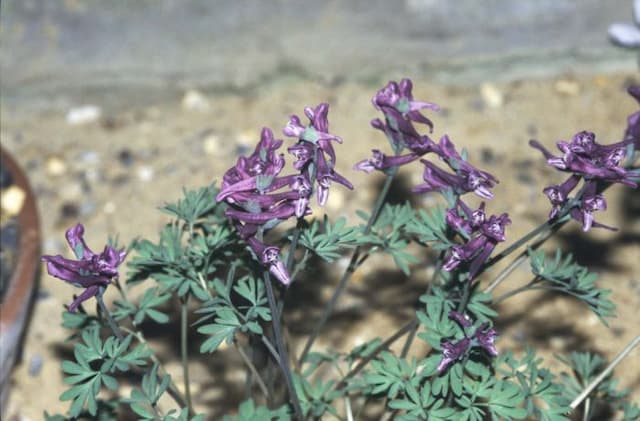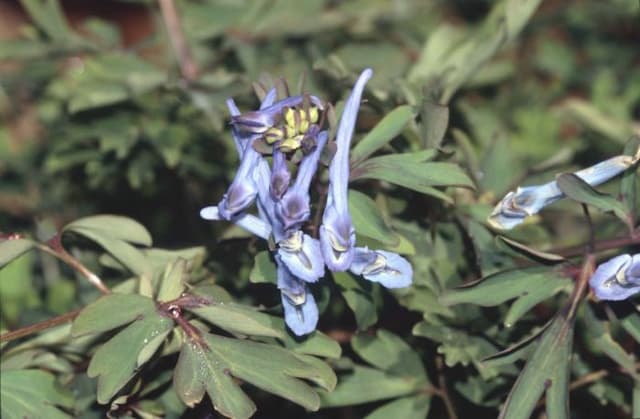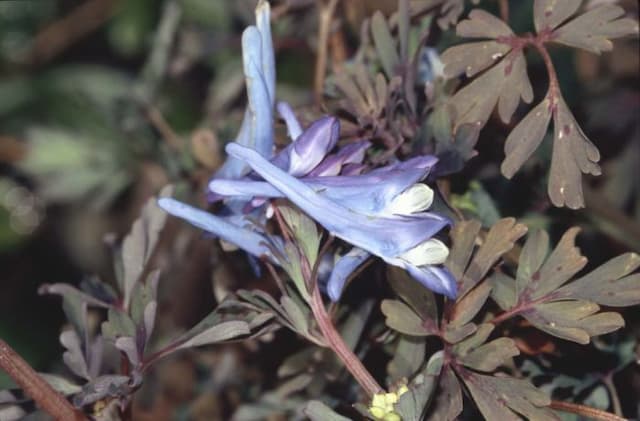Blue Poppy Meconopsis (George Sherriff Group) 'Dalemain'

ABOUT
Meconopsis 'Dalemain', known as the Blue Poppy, showcases a breathtaking display of striking blue flowers. These flowers are easily the most captivating feature of the plant, with a rich, satiny blue hue that is often accentuated with a hint of purple or violet, making them look almost otherworldly. The blooms have a rounded shape, with numerous delicate petals that radiate around a central core of golden-yellow stamens. This deep contrast further highlights the intense blue color of the petals. The flowers are borne on singular, upright stems that arise from a rosette of leaves toward the base. The foliage of the Blue Poppy is also attractive, consisting of green leaves that may have a slight bluish tinge or grayish-green color. They are deeply lobed with a somewhat rough texture and provide a lush backdrop to the flowers. The leaves often have a somewhat wrinkled or puckered look, enhancing their ornamental value. In cultivation, the Blue Poppy thrives in cool, moist environments, reminiscent of its natural habitat. It usually flowers in late spring to early summer, bringing a splash of vibrant color to gardens at that time of year. The stunning visual appeal of Meconopsis 'Dalemain' makes it a favorite among garden enthusiasts who seek to create a striking visual impact with unusual and captivating flowering plants.
About this plant
 Names
NamesFamily
Papaveraceae
Synonyms
Himalayan Blue Poppy, Tibetan Blue Poppy
Common names
Meconopsis 'Dalemain'.
 Toxicity
ToxicityTo humans
The Meconopsis, commonly known as Himalayan blue poppy, does not have a widespread reputation for being toxic to humans. There is limited information available on severe toxicity or poisonings resulting from ingesting any part of this plant. However, as with any plant, individual allergies or sensitivities could potentially cause mild gastrointestinal upset or dermatitis in some people upon contact with or ingestion of the plant. It is always advisable to exercise caution and avoid ingesting parts of ornamental plants due to potential unknowns regarding their toxicity.
To pets
The Meconopsis, commonly known as Himalayan blue poppy, is not frequently reported as a toxic plant to pets. There is limited information suggesting that this species poses significant health risks to cats, dogs, or other domestic animals if ingested. It is always best to prevent pets from eating ornamental plants as even non-toxic plants can cause mild stomach upset or an allergic reaction in some animals. If a pet ingests significant quantities of any plant, it is recommended to monitor for signs of gastrointestinal distress and consult a veterinarian.
 Characteristics
CharacteristicsLife cycle
Perennials
Foliage type
Deciduous
Color of leaves
Green
Flower color
Blue
Height
2-3 feet (60-90 cm)
Spread
1-2 feet (30-60 cm)
Plant type
Herb
Hardiness zones
5
Native area
Himalayas
Benefits
 General Benefits
General Benefits- Ornamental Value: Meconopsis, commonly known as 'Blue Poppy', has striking blue flowers that add a unique aesthetic appeal to gardens and landscapes.
- Habitat Enrichment: It provides shelter and resources for native insects and pollinators, supporting biodiversity.
- Soil Improvement: As it grows and decomposes, it can contribute to the organic matter in the soil, improving soil health and structure.
- Compatibility with Other Plants: Its specific growing requirements can encourage gardeners to plant complementary flora, which can lead to diverse planting schemes.
- Seasonal Interest: It flowers typically in late spring to early summer, offering seasonal color and interest in the garden at that time.
- Educational Value: The cultivation of unique plants like Meconopsis can serve as an educational tool for those interested in botany and horticulture.
 Medical Properties
Medical PropertiesThis plant is not used for medical purposes.
 Air-purifying Qualities
Air-purifying QualitiesThis plant is not specifically known for air purifying qualities.
 Other Uses
Other Uses- Meconopsis, commonly known as Himalayan blue poppy, can be used in thematic garden design to create a Himalayan or alpine landscape aesthetic due to its origin and unique beauty.
- The blue petals of Himalayan blue poppy can be used as a natural dye for fabric and artworks, imparting a delicate blue hue to materials.
- Himalayan blue poppy can be featured in botanical illustrations and photography given its striking appearance, offering a subject for artists and photographers.
- These plants can be utilized in educational settings such as botanic gardens or horticulture programs to teach about plant adaptation and evolution in high-altitude environments.
- The plant is used as a means of attracting pollinators like bees and butterflies to gardens, thereby aiding in the pollination of other plants.
- In colder climates, Himalayan blue poppy may serve as an indicator plant that can signify the successful overwintering of a garden due to its sensitivity to harsh winter conditions.
- As a part of sensory gardens, the delicate structure and bright colors of Himalayan blue poppy can provide visual stimulation and contribute to a diversity of textures and forms.
- The plant may be used in ceremonies or cultural events, especially within the regions of its origin, as a symbol of the Himalayan landscape.
- Himalayan blue poppy can be used in cut flower arrangements for short-term display as they generally do not have a long vase life but offer unique beauty.
- This plant can play a role in conservation education and awareness, highlighting the importance of preserving plant species native to the Himalayan region.
Interesting Facts
 Feng Shui
Feng ShuiThe Blue Poppy is not used in Feng Shui practice.
 Zodiac Sign Compitability
Zodiac Sign CompitabilityThe Blue Poppy is not used in astrology practice.
 Plant Symbolism
Plant Symbolism- Peace and Tranquility: The Meconopsis, commonly known as Blue Poppy, often symbolizes a sense of calm and peace due to its delicate and soothing blue hue which is uncommon in the floral world.
- Imagination and Dreaming: Coupled with its rare color, Blue Poppies are associated with the imaginative realm, evoking creativity and the pursuit of whimsical dreams.
- Success: Despite their challenging growing conditions, when they do flourish, they symbolize success and the reward of perseverance, encouraging one to overcome difficulties.
- Rarity and Uniqueness: Blue Poppies are rare and unique owing to their distinctive color and origin, making them a symbol for what is extraordinary and exclusive.
 Water
WaterFor the Blue Poppy, watering should be done thoroughly, ensuring the soil stays consistently moist but not waterlogged. It's critical to water the plant gently to avoid washing away the soil which could expose the roots. In general, water once or twice a week, providing about a gallon per week, depending on the climate and soil drainage. During hot, dry periods, it may require more frequent watering to maintain the necessary moisture levels. Overhead watering is not recommended as it can promote leaf diseases; instead, water at the base of the plant.
 Light
LightThe Blue Poppy thrives in dappled sunlight to partial shade. It should be planted in a location where it is protected from the harsh afternoon sun, which can scorch its delicate foliage. Ideally, place it in a spot where it receives morning light and is shaded during the hotter part of the day.
 Temperature
TemperatureBlue Poppies perform best in cooler climates with temperatures ranging ideally between 50°F and 65°F. They can withstand brief periods of colder weather down to about 20°F but may suffer if temperatures exceed 75°F for extended periods. To thrive, they require a cool root zone and are often found in higher elevations with cooler air temperatures.
 Pruning
PruningPrune the Blue Poppy to remove spent flower heads, which encourages additional blooms and prevents the plant from expending energy on seed production. The best time for pruning is shortly after the blossoms fade, typically in mid to late summer. It's not necessary to prune this plant heavily; just tidy up the faded flowers and any dead or damaged foliage as needed.
 Cleaning
CleaningAs needed
 Soil
SoilHimalayan Blue Poppy thrives in a moist, well-drained, humus-rich soil mix with a slightly acidic to neutral pH of around 6 to 7. A mixture containing equal parts of loam, peat, and sharp sand is ideal to provide the necessary drainage and fertility.
 Repotting
RepottingHimalayan Blue Poppies should be repotted every two to three years in the spring. Being somewhat delicate, disturbance of the roots should be minimal during the repotting process.
 Humidity & Misting
Humidity & MistingHimalayan Blue Poppy requires high humidity to thrive, ideally between 60% to 80%. They favor cool and humid conditions, much like their native damp, mountainous climates.
 Suitable locations
Suitable locationsIndoor
Keep in cool, humid spot with indirect light.
Outdoor
Plant in dappled shade; protect from wind and harsh sun.
Hardiness zone
7-9 USDA
 Life cycle
Life cycleThe Himalayan Blue Poppy, Meconopsis (George Sherriff Group) 'Dalemain', begins its life cycle as a seed which germinates to produce a small rosette of leaves close to the ground. In the spring, the rosette grows taller, developing a flower stalk and buds. By early to mid-summer, the buds open into the plant’s characteristic large blue flowers. After flowering, the plant sets seed, which can be dispersed by wind or collected for cultivation. If the conditions are not too harsh, the plant may survive the winter and flower again in the following season, although many Meconopsis varieties are monocarpic and die after setting seed. In favorable conditions, new seedlings will sprout from the dispersed seeds and the life cycle begins anew.
 Propogation
PropogationPropogation time
Spring to early summer
The most popular method of propagating the Meconopsis (George Sherriff Group) 'Dalemain', commonly known as Himalayan Blue Poppy, is by sowing seeds. Seed propagation should ideally be done in late winter to early spring. Fresh seeds are sown onto the surface of a moist, well-drained seed compost in trays or pots. The seeds require light for germination, so they are not covered but gently pressed into the compost. The container is then enclosed in a plastic bag or placed in a cold frame, maintaining a steady temperature of about 50-55 degrees Fahrenheit (10-13 degrees Celsius). Germination can be slow and irregular, taking anywhere from 2-4 weeks. Once seedlings are large enough to handle, they should be carefully pricked out and grown on in cooler conditions.









